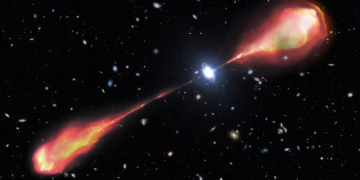Astronomers have made an astonishing discovery: the largest radio jet ever observed in the early universe, spanning an incredible 200,000 light-years—double the width of our Milky Way galaxy. This colossal jet, streaming from a quasar known as J1601+3102, challenges our understanding of how supermassive black holes shaped the cosmos in its infancy.
A Cosmic Powerhouse in the Infant Universe
One of the most remarkable aspects of this discovery is its age. The quasar J1601+3102 formed when the universe was just 1.2 billion years old—less than 10% of its current age. At this early stage, astronomers did not expect to find such enormous radio jets, making this find one of the most extreme ever recorded.
Most known quasars are much brighter and more massive, with black holes billions of times the mass of our Sun. However, J1601+3102 is different. Despite its modest black hole mass of 450 million solar masses, it still produces an unbelievably large and powerful jet. The asymmetry in the two lobes of this jet suggests that the environment of the early universe influenced its structure, making this quasar an important piece of the cosmic puzzle.
What Are Radio Jets, and Why Are They Important?
Radio jets are narrow beams of relativistic particles, propelled outward by the extreme magnetic fields near a supermassive black hole. As matter falls into the black hole, some of it is ejected at incredible speeds, forming these massive structures that stretch for hundreds of thousands of light-years.
In modern galaxies, radio jets are known to regulate star formation by heating surrounding gas and preventing it from collapsing into new stars. This process, called feedback, plays a critical role in the evolution of galaxies. But in the early universe, it was unclear whether such processes were already in effect.
Combining Telescopes Across the Globe
Detecting such a faint, distant object is an enormous challenge. To study J1601+3102, astronomers combined data from multiple telescopes across different wavelengths:
- The Low-Frequency Array (LOFAR) Telescope in Europe first detected the faint radio waves emitted by the jet.
- The Gemini North Telescope in Hawaii captured near-infrared images, helping confirm the quasar’s distance and age.
- The Hobby-Eberly Telescope in Texas provided optical spectroscopic data to measure the mass of the black hole.
This multi-wavelength approach allowed astronomers to see through the cosmic microwave background radiation—the relic heat of the Big Bang—enabling them to detect this enormous structure for the first time.
Why Has It Taken So Long to Find a Jet This Big?
The main reason we haven’t seen many radio jets in the early universe is that they fade over time. By the time their light reaches us, many of them have dimmed to the point of invisibility. Moreover, the cosmic microwave background—the afterglow of the Big Bang—makes it difficult to detect radio waves from such distant objects.
But J1601+3102 is so extreme that it stands out despite these challenges. This quasar’s jet is one of the brightest ever observed, making it a rare glimpse into the past and giving scientists a direct look at how galaxies evolved billions of years ago.
What Does This Mean for Our Understanding of the Universe?
Quasars Shaped the Early Universe
Quasars like J1601+3102 are crucial in understanding the cosmic web—the large-scale structure of the universe. These powerful objects helped shape galaxies by expelling gas, heating intergalactic space, and regulating star formation.
This discovery challenges previous assumptions that such enormous jets formed much later in the universe’s timeline. Instead, it suggests that supermassive black holes were already influencing their surroundings long before scientists had predicted.
Solving the Mystery of Asymmetrical Jets
One of the strangest aspects of this radio jet is its asymmetry. The two lobes—massive structures at the end of the jet—appear uneven in both size and brightness. Scientists believe that external forces in the early universe—such as dense intergalactic gas or hidden magnetic fields—may have distorted the jet, causing one side to appear much brighter than the other.
What Comes Next?
Future Missions Will Unlock More Secrets
With modern technology improving at a rapid pace, this is just the beginning of what astronomers can uncover. Several upcoming missions will play a key role in advancing our understanding:
- The Square Kilometer Array (SKA): Set to be the most sensitive radio telescope ever built, it will detect even fainter radio jets and uncover more quasars like J1601+3102.
- The James Webb Space Telescope (JWST): Already revolutionizing astronomy, JWST will investigate the host galaxies of early quasars, providing insight into how these massive black holes formed.
- The Extremely Large Telescope (ELT): This upcoming telescope will help astronomers examine the gas surrounding early quasars, shedding light on how they interact with their environments.
Final Thoughts: A Window into the Past
The discovery of J1601+3102’s record-breaking radio jet is a monumental step forward in understanding the early universe. This monstrous structure not only challenges existing theories but also opens the door to new possibilities about how supermassive black holes shaped the cosmos.
Reference:
Monster Radio Jet (>66 kpc) Observed in Quasar at z ∼ 5



















